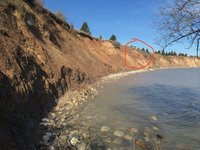bonsai-novice
Mame
Due to the current lockdown, I thought I would have a go at something new. I think I have fairly clayey soil, so I thought I would experiment and see whether I can make some actual clay from the ground.
So far, I have dug down and removed some of the deeper earth which is very clay like, and I have suspended it in boiling water to help any clay get into solution whilst allowing the organic matter, and stones and sand to seperate out. Now these have been removed, I have seived the liquid and I am now just waiting for it to settle out of the water, and I am hoping that there will be some usable clay at the bottom of the bucket.
Should there be any actual clay, I was thinking I could have a bash at making a small pot. Does anyone know whether you can get unglazed bonsai pots as I have only ever seen glazed ones. I think I would be able to fire them up to a temperature where it could be made solid, but I doubt I would be able to get them hot enough to allow them to get glazed.
I am not a potter and I don't think I have even touched clay since I was about 7 years old, so I was wondering whether anyone had and advice, or suggestions about how to make a rustic looking pot?
So far, I have dug down and removed some of the deeper earth which is very clay like, and I have suspended it in boiling water to help any clay get into solution whilst allowing the organic matter, and stones and sand to seperate out. Now these have been removed, I have seived the liquid and I am now just waiting for it to settle out of the water, and I am hoping that there will be some usable clay at the bottom of the bucket.
Should there be any actual clay, I was thinking I could have a bash at making a small pot. Does anyone know whether you can get unglazed bonsai pots as I have only ever seen glazed ones. I think I would be able to fire them up to a temperature where it could be made solid, but I doubt I would be able to get them hot enough to allow them to get glazed.
I am not a potter and I don't think I have even touched clay since I was about 7 years old, so I was wondering whether anyone had and advice, or suggestions about how to make a rustic looking pot?

